![[SoundStage!]](../../titles/sslogo3.gif) Home
Audio Equipment Home
Audio EquipmentFeature Review |
||||||
"Tell me about these speakers." It was the DirecTV installer, who spied the Wilson Audio Alexandria X-2s in my listening room, which also doubles as the living room, shortly after they were set up. I gave him a highly abridged version of what you're about to read, complete with the sobering fact that the Alexandrias weigh over 700 pounds apiece. "Not for me," he replied. "They would buckle the floor of my house." The most persistent reaction an Alexandria owner will have to deal with is simple curiosity. Everyone immediately identifies them as speakers, but speakers unlike any others they've seen. Then there is the inevitable comment, "I bet they play loud." "Yes, they will," I reply. "But they're not just about volume. They're about refinement." This is often followed by a semi-blank stare. Everyone knows what "refinement" means, but what it means in regard to sound is illusive. But I'm getting ahead of myself, something that an Alexandria owner will feel over the course of receiving the speakers and having them set up. Before the massive Alexandrias are even in the listening room, they cause rampant anticipation. However, this is quickly tempered by reality. Delivery, uncrating and assembly of Alexandrias take a considerable amount of time and effort. As I indicated in the first part of this review, a pair of Alexandrias are shipped in seven robust wooden crates that weigh a ton -- literally -- combined. I'm lucky in the sense that my neighborhood has wide streets and little traffic, making it ideal for a large truck to maneuver through. I'm unlucky, however, because my driveway is long and slopes toward the street, which made getting the crates onto my front porch an aerobic workout. I'm sure the Alexandrias make truck drivers grumpy no matter where they are delivered. Pushing the crates up my driveway with the aid of a pallet jack reminded me of pushing a blocking sled. Why not have the driver back into the driveway and let the truck do the work? If your driveway is made of concrete, as mine is, a large truck will crack the slabs. So push and pull it is. Five of the crates contain the upper driver modules, the wing arrays used for aligning them, and the covers that hide all of the cabling and connectors on the back of the speakers. I unpacked nervously. Each piece is "frisked" -- covered with a protective film that's removed after the speakers are placed -- but putting even a small a scratch in the glossy finish would be one of those things that happens in slow motion because of the anguish that would immediately accompany it. "Nooooooo" I muttered as a side panel skimmed the frame of my front door. I heard Barber's Adagio for Strings playing softly in my head. Then I inspected. Hooray! The frisk did its job, taking the brunt of the glancing blow. Earth is saved. Even with the possibility of damage looming, I urge X-2 owners to help with the grunt work of getting their speakers into their listening rooms. It will give you greater appreciation for what you've purchased. Why miss out on fully experiencing your new speakers? Because my front door opens to my listening room and has no steps up to it, I was able to unpack all of the small pieces myself and carry them in. Given their compact size, all of the driver modules are surprisingly heavy, like 40-pound bowling balls, and each wing array is an awkward mass to lift out of its deep cocoon. However, the bass cabinets are a different matter entirely, and I wasn't about to try moving them into place without some help. For the uninitiated, setting up loudspeakers has one of the fundamental elements of great literature: the relationship between the protagonist and the forces against him, which reside either in the world around him (Ahab and Moby-Dick) or within himself (Hamlet and his own indecisiveness). An Alexandria owner has to overcome the speakers and their interaction with the room in which they will be used -- or does he? I've written in the past about setting up a pair of Wilson Audio speakers, a process I've been able to observe closely as a representative from the company has done all of the dirty work. But this is not some sort of reviewer's perk; Wilson Audio requires that its dealers be skilled at setting up its speakers according to the elaborate "voweling in" routine, which finds the best spot in the room for the speakers. Called the "zone of neutrality," this area is the sonic equivalent of the horse latitudes -- the place where the room is at its greatest "calm" and most devoid of detrimental artifacts, including standing waves, slap echo, comb filtering and the like. John Giolas, Wilson Audio's marketing director, has sussed out the "zone of neutrality" in two different of my listening spaces, including my current 20' x 29' room. When he surveyed my room for the MAXX 2s, which I reviewed a year ago, he made copious notes on standardized forms that he and other Wilson Audio setup specialists carry. Therefore, he had the room completely mapped for the Alexandrias and didn't have to go through the entire process again. Even with the "voweling in" already done, setting up the Alexandrias still took parts of two days. The first thing John and Trent Workman, who is Wilson Audio's overseas-sales director, and I did was get the bass cabinets into my room, which involved rolling them through my front door, a total distance of about 30 feet. This is much easier said than done. Each bass cabinet weighs 500 pounds -- more than a completely assembled MAXX 2, more than most refrigerators. We stood the crates up on end, and the bass modules, which are packed on casters, rolled out. Getting them over the threshold of my front door required some thought, however. We decided to use the top panel of the shipping crate as a ramp. We heard it creak and even crack a bit, but it worked. I'm glad the speakers didn't have to go up or down any stairs. As I pointed out in the first part of my review, assembly of the raw elements into a pair of finished X-2s takes three people three days, after which the speakers are partially disassembled for shipping. Even so, reassembling the speakers in the listening room is not quick work, partially because of the measurements and adjustments that must be made. The Alexandria is the first speaker to utilize what Wilson Audio calls "aspherical group delay," which is why it comes in multiple pieces. The upper modules adjust forward and back to optimize the drivers' time alignment and also tilt to achieve ideal dispersion no matter the size of the room or the location of the listening position. Audiophiles and speaker designers alike have wondered aloud how any speaker can be truly time aligned when the listening position is not identical for every potential owner. The Alexandria achieves this through profuse adjustability -- there are 33 different alignment indents for each driver module -- and it optimizes dispersion as well. Of course, aspherical group delay also adds a layer of intricacy to setting up a pair of Alexandrias. Each upper module has to be adjusted for distance and angle to the listening seat, but John and Trent have configured so many pairs of X-2s that they know all of the settings by heart. In my case, with a large space to work with, the position of the listening seat required more adjustment than the speakers' upper modules. But after much experimentation, the listening seat ended up right where it was for the MAXX 2s. Another consideration particular to the Alexandria is the speaker's front-firing port. Every other Wilson Audio speaker has its ports in the rear -- a pair for both the WATT/Puppy 7 and MAXX 2. The MAXX 2's lower port is large enough to put your arm in. Outwardly, the Alexandria's port looks like a large rectangular slot near the bottom of the speaker, but its design and placement were technical problems for the engineers at Wilson Audio. The size and output capability of the Alexandria's woofers require a port that won't chuff when a large volume of air flows through it and won't excite room issues because of the speakers' ample bass output. Wilson Audio solved the problem mathematically, creating a port that the company claims "reduces port turbulence to inaudibility," while its frontal placement makes for fewer setup issues. In my room, the Alexandrias were a few inches closer to the front and side walls than the MAXX 2s, a byproduct of the different port orientation.
John and Trent did the greatest amount of fine-tuning to the placement and toe-in of the speakers, playing a few cuts over and over again to aid them. I must have heard a 20-second snippet from Greg Brown's "Hey Baby Hey" 25 times. In the process of setting up the Alexandrias, this track is used to dial in the midbass and the treble-to-midrange transition. If the speakers sound lean with this track, their overall balance is emaciated, and more fine-tuning ensues. I knew John and Trent were getting close when terms such as "bass discontinuity" and "room mode" gave way to others such as "coherence" and "integration." Movements of 1/2" or less are common and not easy to make, even with the speakers on casters, because the carpet bunches due to the extreme weight. But such adjustments are a necessary part of optimizing the speakers, so John and Trent persist, using masking tape to mark off the distance from both the front and side walls, pushing the speakers this way and that. As the speakers are playing music and being nudged, it's impossible not to speculate on what you expect to hear once it's just you and the music. This same thing occurred when the first pair of Wilson Audio speakers I reviewed, WATT/Puppy 6es, were being set up in my listening room. Before that time, my experience with Wilson Audio speakers was limited to a few show demos and a more lengthy evaluation of WATT/Puppy 5s and a WHOW subwoofer in a dealer's listening room. It was easy to understand the allure of those speakers, but it was hard to love them. They were about detail and wide bandwidth above all else -- to the exclusion of all else, I would have argued at that time. They were the sonic equivalent of an electron microscope -- good for analysis, but not what I would choose purely for pleasure. For some listeners, this notion about Wilson Audio speakers has persisted -- it is part of the company's legacy, after all. However, starting with the WATT/Puppy 6 and moving on to the Sophia and WATT/Puppy 7, Wilson Audio speakers have achieved something that no others I've heard pull off to nearly the same degree. All of the detail is still there, perhaps more than ever before, but the artifacts of reproduction are not. Distortion has been reduced, so that what's left is the music without the sort of noise that denatures tonality and turns detail into a byproduct of analysis, not music. I had only middling expectations for the WATT/Puppy 6es, but I ended up using them as my reference speakers, and the WATT/Puppy 7s after them. And then there are the MAXX 2s, which I called "the most significant product I've written about." I've heard every current Wilson Audio speaker at length, and as you move up the line, each model has greater bandwidth and dynamic capabilities than the one below. Distortion is lower as well, something that seemingly reached its limit with the MAXX 2s. While I watched John and Trent work, digesting bits of music here and there, I pondered what I expected from the Alexandrias in my room and with my electronics -- one has to have expectations for such a speaker. They would certainly improve on the MAXX 2s in some ways, I reasoned, but not in all ways. I had heard the Alexandrias a couple of times, but I lived with the MAXX 2s, and they were simply too accomplished to be "blown away" by any speaker, even another from Wilson Audio. But then I wondered why the Alexandrias exist. As a large manifestation of David Wilson's curiosity? As a textbook example of diminishing returns? Each year at CES I see and hear a handful of high-priced gargantuan speakers, some from familiar makers and others from complete unknowns. Most of these are one-offs used to gauge potential interest, and if the demo pair actually sells (contrary to its trade-only mission, the CES is crawling with consumers), all the better. They aren't real products, the creation of extensive R&D and produced in quantity, but rather bait in an elaborate audiophile fishing expedition. There are now over 150 pairs of Alexandrias in existence, and the backorder list is long, so I knew that the Alexandrias were real. Still, I couldn't conceive of the MAXX 2s being bettered. In fact, I expected to prefer the MAXX 2s in some ways, and I was sure that other listeners would, too. Again, it simply stood to reason given the MAXX 2s' performance in every way I had experienced.
I can almost hear you demanding, "Tell me how these speakers sound." Next time. ...Marc Mickelson
|
||||||
|
||||||
![[SoundStage!]](../../titles/sslogo3.gif) All
Contents All
ContentsCopyright © 2005 SoundStage! All Rights Reserved |


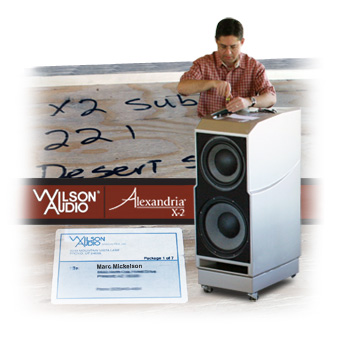
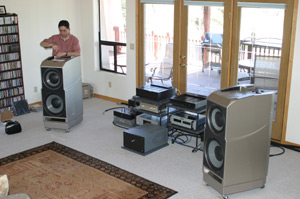
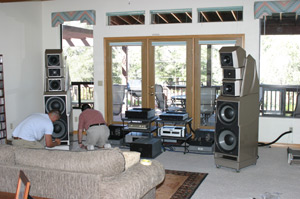
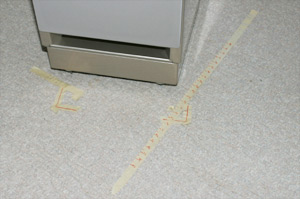
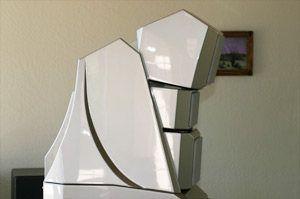
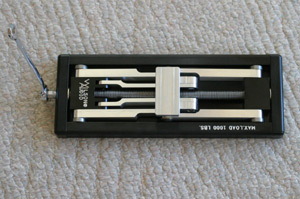 The final step in setting up
Alexandrias is inserting their spiked footers, a task that Wilson Audio has made easier by
including a jack for propping up each speaker. Just put it under the front end, ratchet
the speaker upward, and screw in the spikes; then repeat at the rear. Never do this
side to side, where the speaker is more narrow. It could tip. After installing the spikes,
you may have to adjust the threaded points to level each speaker. Sonics aside, I would
think that the spikes have the added effect of making the Alexandrias nearly theft-proof.
Imagine a burglar's dilemma: he would know that the speakers are something expensive, but
attempting to move them once they've been spiked leads only to frustration and possibly an
impaled hand or foot.
The final step in setting up
Alexandrias is inserting their spiked footers, a task that Wilson Audio has made easier by
including a jack for propping up each speaker. Just put it under the front end, ratchet
the speaker upward, and screw in the spikes; then repeat at the rear. Never do this
side to side, where the speaker is more narrow. It could tip. After installing the spikes,
you may have to adjust the threaded points to level each speaker. Sonics aside, I would
think that the spikes have the added effect of making the Alexandrias nearly theft-proof.
Imagine a burglar's dilemma: he would know that the speakers are something expensive, but
attempting to move them once they've been spiked leads only to frustration and possibly an
impaled hand or foot.